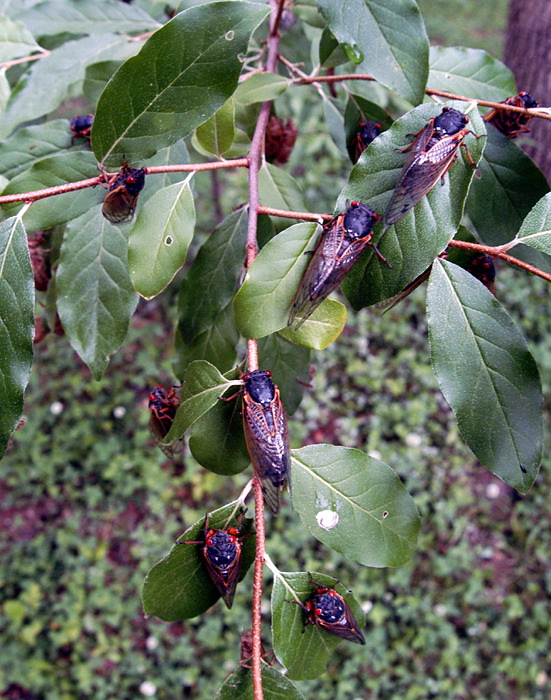
In its month above ground, a cicada morphs from a nymph to an adult, mates and dies, leaving behind eggs embedded in small twigs. (C) Photo courtesy Sam Orr.
In honor of gardeners in the eastern part of the United States, here’s a Hoosier Gardener column that ran in The Indianapolis Star April 21, 2007 about the emergence of the 17-year cicada, which occurred in Indianapolis in 2004. In 2007, a brood emerged in northwest Indiana.
—————
They’re back, this time in northwest Indiana where people are braced for a spring invasion of Brood XIII of the periodical cicadas.
Central and southern Indiana residents recall a similar invasion of the red-eyed insects in 2004, when Brood X emerged after 17 years under ground.
The 2004 emergence and lifecycle of Brood X was captured on video by photographer Sam Orr, in his documentary, the Return of the Cicadas.
Orr, who also has studied forest ecology, teamed up with an expert on the topic, Keith Clay, a professor of biology at Indiana University-Bloomington and director of the Research and Teaching Preserve. Both worked under a grant from the National Science Foundation to research the long-term effects on forests of the one of the largest outbreaks of insects on Earth.
The documentary begins with the awkward, tentative emergence of Cicadidaemagicicada from pencil-size holes, first poking out their heads to test the temperature. If it’s too cool, they slide back in until the next day. And, when it’s just right, they emerge one by one until there are millions of them pulsating on the ground. “There are just so many of them,” Orr said.
It’s like watching a horror movie, repelled, yet compelled to watch.
There are 30 broods of periodical cicadas, some on the 17-year cycle and some on the 13-year plan. “There are some we can’t find, so they may never have existed,” Clay said.

Adult cicadas climb a shrub, preparing to sing for sex. (C) Photo courtesy Sam Orr.
Half-inch, brown nymphs emerge from their cicada huts. After about a week, the nymphs shed their exoskeletons, those tan shells we find on trees, shrubs and the ground. After a short while, cicadas’ wings dry out and the 1 ½-inch long adults turn greenish black. The males begin their mating chorus by vibrating membranes on their stomachs. The females do not sing.
The cacophony lasts a couple of weeks. After mating, the females embed their eggs in small branches on trees and shrubs, and the adults die. In six to 10 weeks, the eggs hatch and the tiny, baby nymphs fall to the ground, eventually burrowing about 18 inches deep, where they dine on a root sap for the next 17 or 13 years.
In the case of Brood X, “they sit there underground for 16 years and 46 weeks and you don’t even know they are there,” Orr said.
It’s not uncommon for there to be three dozen or more exit holes per square foot in heavily infested areas. One woman joked her house might cave in because there were so many exit holes in her landscape, he said.
During their above ground phase, cicadas do not eat plants, sting or bite, so spraying is not recommended. Young trees and shrubs are the most susceptible to branch damage from the egg laying, but the plants can be protected with netting.
Some of the cicadas provide once-in-a-lifetime, nutritious snacks for wildlife. With 2004’s huge proliferation of food, the state reported a big jump in the wild turkey population a few months after the invasion, Clay said.
Although a cicada invasion may be a hard-sell, “I have more empathy for them than most people,” Orr said. He loves telling children about the cicada’s life cycle, including their long stay under ground. “I tell them the cicadas are older than they are.”